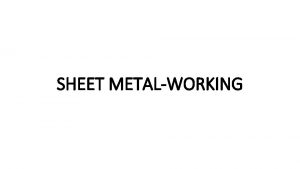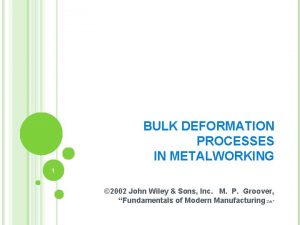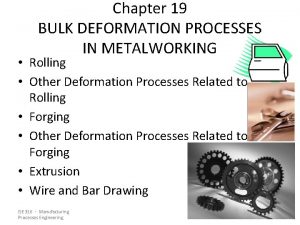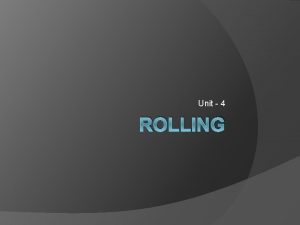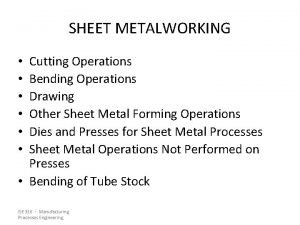National 5 Practical Metalworking During the Practical Metalworking































- Slides: 31

National 5 Practical Metalworking During the Practical Metalworking course you will develop skills, knowledge and understanding of: • • Safe working practices in workshop environments • Metalworking Techniques Measuring and marking out metal sections and sheet materials • Practical creativity and problem-solving skills • Sustainability issues in a practical metalworking context Areas of study: Bench Skills / Machine Processes / Fabrication & Thermal Joining

National 5 Practical Metalworking Unit 1: Bench Skills - Bench Tools

Bench Tools: Marking It is vital to be very accurate when marking out metal in preparation for cutting, bending or forming metal. Engineers will work to strict tolerances, therefore many tools and techniques are used to ensure accuracy of work. Scriber The ‘Scriber’ is used to mark your metal. ‘Engineers Blue’ can be used to help make marks more visible when working. This is simply a heavily pigmented ink wash. A simple dry wipe marker will do for now!

Bench Tools: Marking Scribing Block The ‘Scribing Block’ is used to help accuracy of marking. Especially useful when repeatedly marking the same size. Odd Leg Calipers The ‘Odd Leg Calipers’ are used to accurately mark lines parallel to an edge

Bench Tools: Marking Engineers Square The ‘Engineers Square’ is the metalwork equivalent of the try-square. It has a steel blade o inserted into a steel body at 90. A small notch or ‘relief’ is made in the corner of the square to prevent small particles from accumulating and affecting the reading. Centre Punch Made from High Carbon Steel, The ‘Centre Punch’ is used to mark centres of holes before drilling. It can also be used carefully for witness marking.

Bench Tools: Marking Witness Marks When lines have been scribed, they tend to fade due to exposure. This fading can be overcome by putting ‘witness marks’ along scribed lines. These traditionally are made with dot punches (thinner version of a centre punch) but can also be done with a centre punch, so long as you vary the force applied. Just a tap!

Bench Tools: Marking Surface Table or Plate A ’Surface Table’ or ‘Plate’ is a solid, flat surface used as the main horizontal reference plane for precision marking and inspection. The surface plate is often used as the baseline for all measurements to a work piece. Plates are typically square or rectangular. One current British Standard includes specifications for plates from 160 mm × 100 mm to 2500 mm × 1600 mm.

Bench Tools: Measuring Spring Dividers The ‘Spring Divider’ is used much like a compass would be on paper, it will mark a radius on your material. It is good practice to use a centre punch before use. Steel Rule The 300 mm (metric) ‘Steel Rule’ is used to accurately measure your material. We only measure in metric/mm but often a rule will give imperial/inches.

Bench Tools: Measuring Inside Calipers The ‘Inside Caliper’ measures inside diameters of holes or pipe sections. Outside Calipers The ‘Outside Caliper’ measures the outside diameter of bar sections. In both cases the ‘Vernier Gauge’ is far more accurate.

Bench Tools: Measuring Set and Adjustable Angle Blocks The ‘Angle Block’ is useful for drilling, milling and set up jobs where a particular angle to a reference face is required. Adjustable Angle Blocks allow the job to be held at any angle 0 -60° for angular machining jobs. Combination Set The ‘Combination Set’ has multiple uses across metalworking, woodworking and stonemasonry. It is composed of a ruled blade and several interchangeable heads (usually three) that may be affixed to it.

Bench Tools: Measuring Vernier Gauge The ‘Vernier Gauge’ is a very accurate tool as it uses the Vernier scale to read between the main scale increments. It can measure inside and outside diameters as well as hole depth.

Bench Tools: Measuring Micrometer The ‘Micrometer’ is an extremely precise instrument that uses a finely calibrated screw to measure outside diameters.

Bench Tools: Clamping Engineer’s Vice The ‘Engineer’s Vice’ is used to firmly secure material when working. Remember, when not in use the handle should not be tightened! This means it will not budge if you walk into it! Soft Jaws ‘Soft Jaws’ can be used to protect material from surface scratches. These can occur due to the hard, grooved fixed jaws on the vice. Soft jaws will usually be made from nylon or soft metal like Aluminium.

Bench Tools: Clamping Machine Vice The ‘Machine Vice’ is used to secure material when machining. This is mainly used at the Pillar Drill and can be fixed to the bed/table of the drill. Hand Vice The ‘Hand Vice’ is used to secure small sections of material when working.

Bench Tools: Clamping V - Block The ‘V - Block’ is used to secure metal section when cutting, drilling or milling. Mole Grips ‘Mole Grips’ are versatile and can be used to secure material during a number of different workshop operations.

Bench Tools: Clamping Engineers Pliers ‘Engineers pliers’ are Multi purpose pliers used for gripping small objects and cutting fine wire. Toolmakers Clamp The ‘Toolmakers clamp’ can be used to hold small pieces of work while working on them.

Bench Tools: Cutting Hacksaw The ‘Hacksaw’ is used to cut material of various thicknesses. Junior Hacksaw The ‘Junior Hacksaw’ is used to cut smaller sections of material.

Bench Tools: Cutting Drill Bits The twist ‘Drill Bit’ used in the metal workshop is known as a high-speed steel (HSS) Twist Drill Bit and is characterised by it’s black colour. More expensive, durable bits may contain cobalt or be titanium coated. Tin Snips The ‘Tin Snips’ are used to cut sheet metals. There are many types used for various jobs. The main types are ‘straight cut’ and ‘curved cut’. These come left and right handed. For finer work a slimmer version called ‘jewellery snips’ can also be used.

Bench Tools: Cutting Cold Chisel The ‘Cold Chisel’ is normally made from High Carbon Steel and is made in a variety of sizes. These are used to cut metal but can be used for brick and concrete. Hand Countersink The ‘Countersink’ can be used to remove the sharp burr from drilled holes.

Bench Tools: Cutting Files The ‘File’ is used to cut, shape and finish metal. The file comes in various shapes and cuts to suit different jobs. The files ‘tang’ secures the file to the handle. Never use a file with a damaged or missing handle! End Cutters The ‘End cutters’ are used to cut rivets to the desired length.

Bench Tools: Cutting Taps The ‘Tap’ is used when ‘Tapping’ a hole. This is the process of cutting a thread inside a hole so that a cap screw or bolt can be threaded into the hole. Taps are made from (HSS) and usually come in sets of three; Taper, Intermediate or Second and Plug Tap. These are used for different types of holes The choice of Tap and the preparation of the hole is vital for the successful cutting of an internal thread. We will look at this in detail later. Tap Wrench The ‘Tap Wrench’ is used to secure and turn the Tap square to the work piece, ensuring proper alignment and an even thread. The clamp is opened to insert the tool and then tightened down against the tool to secure it.

Bench Tools: Cutting Dies The ‘Die’ is used when ‘threading’ a bar. This is the process of cutting external screw threads, also known as male screw threads (e. g. , a bolt). The Die can be round, hex, split or solid. The most commonly used, and the one we will use, is the round split die. Both the Die and the Tap can be used to clean out existing threads, this is a process called ‘Chasing’. Die Stock The ‘Die Stock’ is used to secure and turn round and hex dies, ensuring proper alignment and a uniform thread. The Die is secured in the stock using three screws, two ‘locking’ screws on the outside and the ‘expanding’ screw in the middle. We will look at the adjustment of the Die Stock in detail later on in the course.

Bench Tools: Joining Pop Rivet Pliers Pop riveting is a technique that is used to join thin pieces of metal. The rivet has two parts; the pin and the rivet. The ‘Pop Rivet Pliers are used to pull the pin through the rivet and as this happens the rivet is deformed slightly so that it joins the metal. Rivets The ‘Rivet’ is a metal pin used to permanently join together two plates of metal, its headless end is beaten out or pressed down when in place. A rivet consists of a cylindrical shaft with a head on one end and the opposite end is called the tail.

Bench Tools: Joining Rivet Set & Snap The ‘Rivet Set & Snap’ can be used when setting the rivet in place with the ‘set’ end. The ‘snap’ end is used when forming the head on the solid rivet. Adjustable Spanner The ‘Adjustable spanner’ will fit any nut/bolt up to 34 mm in size. While an adjustable spanner is a useful tool to have, it is preferable to use a normal spanner as it is less likely to round the corners of a nut/bolt.

Bench Tools: Forming Anvil The ‘Anvil’ is a block of cast or forged steel. The very hard surfaces are used in many ways to strike and form metals. The better the quality of anvil the more efficiently it will cause the energy of the striking tool to be transferred to the work piece. Rawhide or Rubber Mallet The ‘Rawhide’ or the ‘Rubber’ mallet is a must in the metal workshop as it can be used to form and shape metal without leaving hammer marks.

Bench Tools: Forming Repousse Hammer This ‘Repousse hammer’ (sometimes called a chasing hammer) is a great tool forming and raising shapes from sheet metal. The word 'repousse' comes from the French verb meaning 'to push back' and it is one of the oldest metalsmithing techniques in the world. Ball-Pein Hammer The ‘Ball-Pein’ hammer, also known as the machinists hammer, was mainly used for ‘peening’ (the act of surface hardening by impact). Nowadays it is used for many tasks such as striking punches or and chisels. It is also used for rounding of edges and fasteners such as rivets.

Bench Tools: Forming Folding Bars The ‘Folding Bars’ are used in conjunction with the vice to insure an accurate bend when working with sheet metal or thin plate. A rawhide mallet and a piece of wood should be used to protect the material from damage when working.

Bench Tools Number & Letter Punches The number & letter punches can be used to mark soft metals. When using the letter stamps make sure that. . 1. You are working on a hard surface (an anvil). 2. The lettering on the stamp is facing you. 3. Like with a centre punch, you strike the stamp with one firm blow.

Bench Tools The Bench Grinder The ‘Bench Grinder’ is a benchtop type of grinding machine used to drive abrasive wheels. These types of grinders are commonly used to hand grind various cutting tools and perform other rough grinding. Depending on the grade of grinding wheel, it may be used for sharpening cutting tools such as tools, drill bits, chisels, and gouges. Alternatively, it may be used to roughly shape metal prior to welding or fitting. Also, a wire brush wheel or buffing wheel can be interchanged with the grinding wheel in order to clean or polish work pieces. Stiff buffing wheels can also be used when deburring. Bench grinders are standard equipment in metal fabrication shops and machine shops, as are handheld grinders (such as angle grinders).

Quiz Questions 2. 0 Record answers in your notes jotter 1. What can we use to help us see scribed lines? 2. What tool should I use before marking with the ‘Spring dividers’? 3. What is a characteristic of the drill bits used in the metal workshop? 4. What do we use the countersink bit for? 5. Name the tool I can use to mark a line parallel to an edge? 6. What is the name given to the handle insert on a file? 7. What sizes can I measure with the ‘Vernier gauge’? 8. Name four types of rivet. 9. What type of clamp should I use to secure long sections of bar when drilling? 10. What tool(s) should be used to form the head on a solid rivet?

Quiz Questions 2. 0 Record answers in your notes jotter 1. What can we use to help us see scribed lines? Engineers Blue 2. What tool should I use before marking with the ‘Spring dividers’? Centre Punch 3. What is a characteristic of the drill bits used in the metal workshop? Black in colour 4. What do we use the countersink bit for? Remove Burr 5. Name the tool I can use to mark a line parallel to an edge? Odd Leg Caliper 6. What is the name given to the handle insert on a file? Tang 7. What sizes can I measure with the ‘Vernier gauge’? Outside, inside diameters & Depth 8. Name four types of rivet. Snap, Countersunk, Flat, Pop 9. What type of clamp should I use to secure long sections of bar when drilling? V-Block 10. What tool(s) should be used to form the head on a solid rivet? Set & Snap, Ball Pien Hammer
 Guerin bending process
Guerin bending process Metalworking hand tool
Metalworking hand tool Sqa appointee portal
Sqa appointee portal National 5 practical cookery
National 5 practical cookery Hình ảnh bộ gõ cơ thể búng tay
Hình ảnh bộ gõ cơ thể búng tay Cái miệng nó xinh thế chỉ nói điều hay thôi
Cái miệng nó xinh thế chỉ nói điều hay thôi Cách giải mật thư tọa độ
Cách giải mật thư tọa độ Từ ngữ thể hiện lòng nhân hậu
Từ ngữ thể hiện lòng nhân hậu Tư thế ngồi viết
Tư thế ngồi viết Thứ tự các dấu thăng giáng ở hóa biểu
Thứ tự các dấu thăng giáng ở hóa biểu Chó sói
Chó sói Thẻ vin
Thẻ vin Thơ thất ngôn tứ tuyệt đường luật
Thơ thất ngôn tứ tuyệt đường luật Hổ đẻ mỗi lứa mấy con
Hổ đẻ mỗi lứa mấy con Thế nào là hệ số cao nhất
Thế nào là hệ số cao nhất Diễn thế sinh thái là
Diễn thế sinh thái là Lp html
Lp html Vẽ hình chiếu vuông góc của vật thể sau
Vẽ hình chiếu vuông góc của vật thể sau 101012 bằng
101012 bằng Lời thề hippocrates
Lời thề hippocrates Vẽ hình chiếu đứng bằng cạnh của vật thể
Vẽ hình chiếu đứng bằng cạnh của vật thể Tư thế worm breton
Tư thế worm breton đại từ thay thế
đại từ thay thế Quá trình desamine hóa có thể tạo ra
Quá trình desamine hóa có thể tạo ra Khi nào hổ mẹ dạy hổ con săn mồi
Khi nào hổ mẹ dạy hổ con săn mồi Thế nào là mạng điện lắp đặt kiểu nổi
Thế nào là mạng điện lắp đặt kiểu nổi Các châu lục và đại dương trên thế giới
Các châu lục và đại dương trên thế giới Dot
Dot Nguyên nhân của sự mỏi cơ sinh 8
Nguyên nhân của sự mỏi cơ sinh 8 Bổ thể
Bổ thể độ dài liên kết
độ dài liên kết Thiếu nhi thế giới liên hoan
Thiếu nhi thế giới liên hoan













































